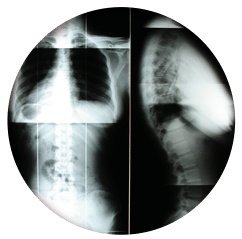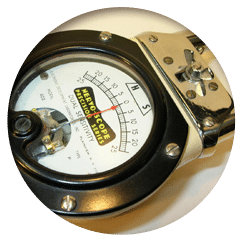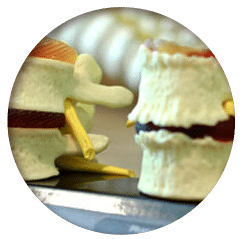5 Components of the Gonstead technique
Why make a decision concerning someone’s health with anything less than ALL of the available information? Every patient deserves to have correlated analysis in their clinical picture to ensure the highest level of chiropractic care in North Liberty IA. This will ensure specificity and ultimately patient confidence in the doctor’s ability with care.
A Gonstead chiropractor uses five basic components to determine how to specifically find and correct subluxations of the spine and extremities. Not one thing is certain which is why we use Visualization, Instrumentation, Palpation, X-Ray, and patient symptoms to determine the exact spot that we need to adjust a patient. When all of these correlate we are more likely to give the patient a specific adjustment. The greater the specificity, the greater the change we will notice in the patient’s health. Dr. Gonstead noted that three adjustments on the wrong vertebral segment could cause a Subluxation; therefore it is extremely important to be as specific as possible.
X-RAYS
In the Gonstead System are Full Spine, both A-P and Lateral views. The film size is 14” x 36” with the patient placed to include ishia to occiput. Full Spine films use less radiation than sectionals, provide an accurate vertebral count, provide full spinal contour representation for posture analysis with axial weight-bearing, and show problems other than the chief complaint—all of which are not attainable through the use of sectional films. Full spine X-Rays are essential to Gonstead Chiropractic. They allow us to regard the patient totally in analysis and corrective procedures.
If necessary, Dr. Kayla will take an x-ray film of the entire spine to be able to actually see what she is working with. The films will give her the ability to most accurately be able to adjust the spine at the exact angle it needs to be adjusted. You wouldn't let a mechanic work on your car without opening the hood and seeing the problem, so why would you want Dr. Kayla to work your health without seeing the very anatomy their affecting?
PALPATION
Both Static and Motion Palpation are utilized in Gonstead Chiropractic to precisely pinpoint areas of involvement. Static Palpation is the “hands on” part of the examination. This will indicate changes in contour, tone, texture, and temperature on the patient. Motion Palpation is used to determine a subluxation and its listing. Dr. Kayla uses her hands to feel how the bones of the spine (vertebra) are moving or not moving. She also feels for areas of swelling and muscle spasm.
INSTRUMENTATION
Dr. Kayla uses an instrument called a Delta T/Nervoscope which detects uneven heat distribution along the spine which can indicate nerve irritation/ subluxation. She will run the instrument down the entire spine, from your head to your hips. The instrument feels like two fingers gliding along your spine. It is actually a very sensitive thermometer that is continually comparing the temperature along your back to find the irritated nerve. An irritated nerve will make the skin/area around it warmer, like a sprained ankle will get hot and swollen.
VISUALIZATION
We take into account all the information we can get from the patient by simply looking at them very carefully. In the Gonstead System Visualization starts from the moment the patient walks in the door. Differences in height between the ears, shoulders, and hips as well as posture and gait are useful to confirm your X-Ray and Palpation findings. Dr. Kayla will take the time to analyze your posture. She looks at everything from the direction your toes point to how your head sits on your shoulders. She even analyzes your gait and how your spine is affecting how you walk.
CASE MANAGEMENT (Symptomatology)
Although never used in a “cookbook” fashion, understanding problems with a patient’s health help us determine the area that a patient needs to be adjusted. Symptoms can help separate the two parts of the Autonomic Nervous System (Sympathetic and Parasympathetic) and aid us in applying a specific adjustment
In the Gonstead System, we apply all the information from these modes of analysis and correlate our findings to determine the most likely cause of the patient’s problem. After Subluxations are found, the use of the proper Gonstead technique is applied to effectively correct problem areas.
The Gonstead System focuses on the dynamics of intervertebral disc as the underlying cause of subluxations and resulting neurological dysfunction. It could then be said that Gonstead doctors are “disc doctors”.
Dr. Kayla will take a thorough patient history to be able to fully understand you. Yes, she is a spine doctor, but she will look at your entire body to be able to best help you achieve optimal health.
Dr. Gonstead postulated that when the Parallel Disc relationship is compromised by vertebral misalignment the pivot point of the nucleus pulposus is compressed and puts pressure against the surrounding annular fibers damaging them.
This tissue damage creates an inflammatory response causing the disc to expand, and it is this expansion that puts pressure on the nerves in a given intervertebral foramen resulting in neurological dysfunction.
The Gonstead system says for this reason that subluxations begin at the disc, it is important to understand the stages of degeneration so as to visualize what adjusting direction and force must be applied for correction.
In the spine intervertebral discs act as both a protective cushion allowing for flexibility as well as a supportive coupling between vertebral bodies to ensure a normal and healthy range of motion.
The Nucleus Pulposus is the dense central mass that holds fluids and nutrients and functions as a pivot point or “ball bearing” during the movement of a vertebral couple. The Annulus Fibrosis is the outlying layers of fibrocartilage and collengenous fibers, much the “rings” observed in a cross-section of a tree trunk. The Annulus is anchored to the cartilaginous endplates of adjacent vertebral bodies.
Dr. Gonstead’s Level Disc Theory states that “anatomically and physiologically normal discs will allow the vertebral bodies to assume their optimum relationships”. This is observed when the vertical height of a vertebral couple is uniform 360º around with the vertebral bodies in line. This relationship is known as “Parallel Discs” and allows for equal weight-bearing, adequate nutrient supply, and optimal joint function and movement in the spine.
Monday
8:00am - 6:00pm
Tuesday
Closed
Wednesday
8:00am - 6:00pm
Thursday
8:00am - 5:00pm
Friday
8:00am - 1:00pm
Saturday & Sunday
Closed
Kay Family Chiropractic
710 Pacha Pkwy #4
North Liberty, IA 52317








